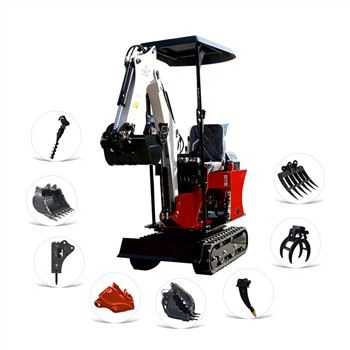Introduction
In the heavy machinery field, selecting the right attachments is crucial. Whether in earthmoving, demolition, mining, or municipal projects, the right attachment not only enhances work efficiency but also ensures safety. This article will delve into how to assess work type requirements to help you choose the most suitable attachments.

1. Understanding Work Types
1.1. Classification of Different Work Types
Different types of projects have varying requirements for attachments. Here are some major work types:
- Earthmoving: Primarily involves digging, transporting, and filling soil.
- Demolition: Includes the tearing down of buildings and structures, requiring powerful and precise control.
- Mining: Involves handling hard materials in complex terrains.
- Municipal Projects: Includes road construction, drainage systems, and infrastructure maintenance.
1.2. Special Requirements for Each Work Type
Each project type has its unique needs. For example:
- Earthmoving typically requires large-capacity buckets to improve efficiency.
- Demolition demands high-efficiency attachments like hydraulic hammers to handle solid structures.
- Mining requires durable equipment to withstand harsh environments.
- Municipal projects may need multifunctional attachments to adapt to various job requirements.
2. Assessing Work Requirements
2.1. Analyzing Project Specifications
Before selecting attachments, it’s essential to analyze the specific requirements of the project:
- Depth and Width Requirements: Determine the required digging depth and working range to choose the right attachment size and type.
- Load Capacity: Assess the weight of materials to ensure the attachment can handle the load.
- Operational Precision: Certain projects may require high precision, such as working in confined spaces.
2.2. Considering the Work Environment
The work environment significantly affects attachment selection:
- Terrain Type: Flat surfaces and rugged terrains require different types of attachments.
- Weather Conditions: Some attachments may be impacted by rain or snow, necessitating the selection of suitable equipment.
2.3. Equipment Compatibility
Ensuring compatibility between attachments and existing equipment is also key:
- Check Specifications of Excavators or Machinery: Different machine models may require different attachments.
- Matching Attachment Types: Ensure the selected attachments can connect properly with the equipment’s systems.
3. Common Attachment Types and Applications
3.1. Buckets
- Uses and Applicable Scenarios: Buckets are the most common attachments, suitable for earthmoving and material loading.
- Choosing Different Sizes and Shapes: Select the appropriate size and shape to meet specific project needs.
3.2. Hydraulic Hammers
- Suitable Work Types: Hydraulic hammers are ideal for demolition and rock breaking tasks.
- Selection Criteria: Choose the right hammer model based on material hardness and work environment.
3.3. Graders and Blades
- Uses and Advantages: Graders and blades are used for land leveling and surface treatment.
- Applicable Project Types: Suitable for large-scale land leveling and infrastructure construction.
3.4. Other Specialized Attachments
- Drilling Machines, Grapples, etc.: Select specialized attachments based on project requirements to enhance efficiency.
- Applications of Each: For example, grapples are used for grabbing and moving heavy objects, while drilling machines are used for foundation piling.

4. Practical Tips for Choosing Attachments
4.1. Understanding Attachment Manufacturers
- Brand Reputation and Quality: Choose reputable brands to ensure quality and durability.
- After-Sales Service and Warranty Policies: Understand the manufacturer’s after-sales service for support when needed.
4.2. Conducting Market Research
- Referencing Industry Reviews and User Feedback: Look up industry reports and user reviews to understand attachment performance.
- Consulting Professionals: Engage with experienced professionals for advice and recommendations.
4.3. Considering Cost-Effectiveness
- Budget Constraints: Select attachments that fit within the project budget.
- Balancing Performance and Price: Find the best balance between performance and cost to ensure a reasonable investment.
5. Conclusion
Choosing the right attachments is vital for improving work efficiency and ensuring safety. By deeply understanding work types, assessing project requirements, and thoroughly researching attachments, you can make informed choices that enhance construction outcomes.
6. Frequently Asked Questions (FAQ)
- Common Misconceptions in Attachment Selection: Many overlook matching attachments to work types, leading to inefficiencies.
- How to Determine Attachment Durability: Check the manufacturer’s information and user reviews to assess the lifespan of attachments.


